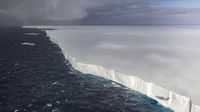For nearly four decades, a colossal slab of Antarctic ice known as A23A has captured the attention of scientists and the public alike, its slow and spectacular journey across the Southern Ocean chronicled by satellites, research ships, and the occasional lucky observer. But as of September 2025, the world’s oldest and, until recently, largest iceberg is on the brink of vanishing, its once-mighty form splintering into smaller fragments as it drifts ever northward into warmer waters near South Georgia Island.
Iceberg A23A’s story began in dramatic fashion back in 1986, when it calved from the Filchner-Ronne Ice Shelf along a massive crack long known to researchers as the “Grand Chasm.” According to NPR, scientists had been watching this fissure since the 1950s, waiting for the inevitable moment when the ice would break away. When it finally did, A23A was a staggering sight—roughly the size of the Hawaiian island of Oahu at the time, and over the years, it has been compared to the U.S. state of Rhode Island and, more recently, the city of Houston as it gradually diminished in size.
For much of its existence, A23A remained grounded in the frigid shallows of the Weddell Sea, stuck to a sandbank that effectively put its demise on pause. This unusual grounding allowed the iceberg to survive in colder waters far longer than most of its peers, earning it the distinction of being both the oldest and, for many years, the largest iceberg on the planet. The British Antarctic Survey (BAS) notes that A23A has held the “largest iceberg” title multiple times, occasionally losing it to even larger but shorter-lived bergs, only to reclaim the crown when those rivals broke apart.
It wasn’t until 2020 that A23A finally broke free from its icy moorings, embarking on a slow drift northward. By late 2023, the iceberg had started spinning in a kind of ocean vortex known as the Taylor column, according to NPR, before strong currents eventually propelled it farther north toward the open sea. In early 2025, A23A was still a behemoth, weighing in at an estimated trillion tons and covering an area comparable to Rhode Island. But as it entered the warmer waters north of Antarctica, the iceberg’s fate was sealed.
Satellite images and aerial surveys, as reported by CNN, show A23A breaking apart into multiple sizable sections, with fragments now drifting near South Georgia Island in the South Atlantic Ocean. The U.S. National Ice Center has even designated these new chunks as separate icebergs—A23D, A23E, and A23F—testament to the scale of the disintegration. By September 2025, BAS oceanographer Andrew Meijers told NPR the iceberg had shrunk to about 1,700 square kilometers (656 square miles), roughly the size of Greater London, and was now floating in waters well above freezing.
Ted Scambos, a senior research scientist at the University of Colorado Boulder, described the sight in vivid terms: “It’s a huge wall, a Game of Thrones style wall of ice that towers above the ship.” But even as he marveled at its size, Scambos was clear-eyed about the iceberg’s prospects. “It’s still quite thick, but it’s a lot thinner than it was when it left the continent,” he told The Associated Press. “Now it’s being flexed by long period waves, by tides, which sweep across the area. And with that flexing, even though it’s incredibly gentle and subtle, it’s finding weak spots in the iceberg, and those are breaking off.”
Both Scambos and Meijers expect the fracturing to accelerate as the Antarctic spring (September-November 2025) gives way to summer. If A23A survives the spring, Scambos warned, the summer heat could trigger a dramatic, almost instantaneous collapse: “It will look sort of like an avalanche that’s floating and could even fall apart in a single day.” The iceberg’s demise is not just a spectacle; it’s a window into the natural processes that have shaped Earth’s polar regions for millennia.
“It’s really quite typical and normal,” Scambos told NPR. “It is kind of a big, spectacular thing that our planet does as part of day-to-day operations.” Meijers echoed this sentiment, emphasizing that megabergs like A23A are born and decay in cycles driven by ocean currents and warmer waters, especially near South Georgia Island. This is a process that has unfolded for centuries, and, as Meijers put it, “it’s an interesting thing to watch, certainly not unprecedented.”
Still, scientists are acutely aware that while iceberg calving is a natural phenomenon, climate-driven changes are increasingly influencing the pace and scale of these events. CNN notes that experts are keeping a close eye on how warming seas and shifting currents may accelerate the breakup of icebergs like A23A in the future. For now, though, the consensus among researchers is that A23A’s journey and demise are part of a longstanding natural cycle, not directly attributable to climate change.
The end of A23A’s journey is not without scientific value. Earlier in 2025, researchers collected samples from the waters and ecosystems affected by the iceberg’s passage. According to the British Antarctic Survey, these samples will help scientists better understand how the mixing of fresh meltwater and saltwater impacts ocean carbon levels and marine life—a crucial piece of the puzzle when it comes to predicting long-term changes in the global environment.
As Scambos explained, “It’s another opportunity to understand some of the processes that govern those mega glaciers. And in fact, those are very important in terms of controlling sea level rise in the long term, decades to centuries from now.” While the melting of floating ice shelves like A23A does not directly raise sea levels, their disappearance can accelerate the flow of land-based glaciers into the ocean, which does contribute to rising seas over time, as reported by The Economic Times.
In a final act of drama, A23A appeared as if it might collide with South Georgia Island earlier in 2025, raising concerns for the region’s seal and penguin colonies. Ultimately, it grounded about 50 miles offshore, sparing the wildlife but providing yet another reminder of how these icy giants can shape the environments they encounter.
As A23A continues to shrink, the title of world’s largest iceberg has passed to D15A, which is nearly twice the size of the diminished A23A, according to Meijers. But for the scientists who have followed A23A’s epic journey, its impending disappearance marks the end of an era—a natural marvel, now fading into history, but leaving behind a legacy of discovery and insight that will inform research for years to come.






